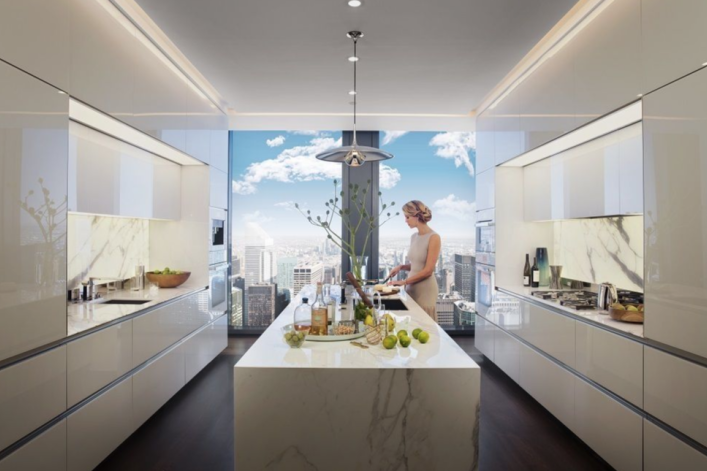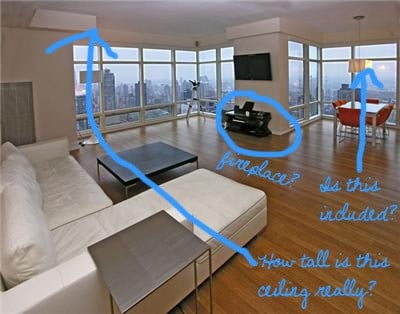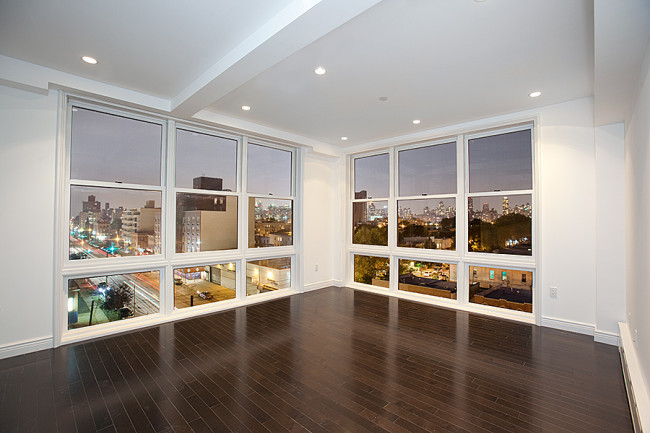Considering a new development condo? Ask these questions to separate reality from slick marketing

A promotional image for apartments at 53 West 53rd St., which feature interiors by Thierry Despont.
There’s an excess of shiny new buildings going up around New York City. (The fact that there’s a surplus is another story.) For people interested in buying an apartment in one of those buildings—particularly shoppers who want first dibs on what’s available—that means signing a contract for an apartment that doesn’t actually exist yet.
Instead of attending an open house where they can check the space they will eventually live in, use the fixtures, experience the views and more, these prospective buyers have to rely on a variety of marketing materials and sales agents to help them understand what, exactly, their future home will be like, when construction is completed. Resources include a development’s website (which often features stunning renderings of residences and amenities), a showroom or sales gallery, and later in the process, a furnished model apartment.
It’s all very seductive, and for good reason. But how, as a shopper, can you separate marketing gloss from the “product” you are buying and move into an apartment that looks and feels like what you envisioned when you signed on the dotted line?
Below, some advice on what questions to ask.
Keep your eyes wide open
Remember that every level of a development’s presentation is created with the intent to make you love it.
“A website is an invitation for consumers to learn more,” says Hunter Frick, SVP of Marketing for Halstead Property Development Marketing. “It’s impossible to render every apartment type. The imagery is representative of what is offered, but not unit specific.”
If the website is a hint, then the showroom is bigger taste.
“New development sales galleries offer potential buyers a quick glimmer, a quick fantasy, a small fraction of the concept behind its design, its architecture, its services,” says Aleksandra Scepanovic, managing director of Ideal Properties Group.
Developers aren't necessarily conveying every aspect of what it's like to live there, so you need to arm yourself with a plan.
Anchor yourself with 'must-haves'
Shopping for an apartment is an overwhelming process when you can physically see your options; it can be more so when the space in question is hypothetical.
“Go in with your top three deciding factors,” says Frick. “There are always compromises. It’s an overwhelming process if you don’t have touch points. If you do a lot of laundry, is the dryer vented? If you cook a lot, is the hood vented? If you’re a light sleeper, is there additional sound attenuating? If you’re always hot, can you get A/C in the winter?”
Think about what you can’t see
It’s easy to forget that some of the biggest quality of life issues involve environmental factors you can’t actually see: noise, temperature, even internet speed. Look beyond the finishes and fixtures and find out what’s behind the walls or floors. Ask about what about noise-dampening features, for example, if that's something important to you.
Get an experienced, independent real estate attorney to review the offering plan
Every project is legally required to have an offering plan, which detail the financials, floorplans, construction issues, by-laws, and more. It’s a hefty document (often literally), and contains a fair amount of legalese. Your independent real estate lawyer—importantly, not one recommended to you by anyone connected to the project—should review the offering plan for any red flags, with particular attention paid to the "special risks" section.
Among other things, the offering plan will explain how the square footage of an apartment is calculated, and could reveal your prospective apartment isn’t quite as big as you thought. “Sometimes [the figure] will include a common area, or if it’s a full floor, the elevator shaft and egress,” says Frick.
Consider materials en masse, ask about upgrades
A showroom will have samples of materials and finishes; remember to picture them used on a large scale—the entire floor, all of the cabinetry, the whole counter—as well as the particular aspects of those materials.
“The buyer must spend the time trying to understand and visualize the space and how in particular the finishes are going to affect it,” says Scepanovic. “For example, is the kitchen cabinetry matte or glossy? Is the backsplash glass, solid surface, tile, paint? How would the light bounce off of these surfaces? How would that affect the quality of light in the interior?”
Since you are in a sales environment, it’s unlikely agents won’t alert you to this, but many developments offer upgrades, so if you don’t like a “standard” option, you can likely pay more for something you prefer.
Think about substitutions
With contracts being signed as much as one or even two years in advance of completion, it’s inevitable that some elements of your apartment won’t be what was offered initially.
“It’s unrealistic that there won’t be substitutions, just factoring the production timeline,” says Frick, who notes that legally a developer is required to substitute with pieces of equal or better quality. (This is more likely to happen with appliances and fixtures, which are products that are more in flux than say, the natural stone of a counter or vanity top.)
Know your way around a rendering
If your building does not exist yet, it’s logical that the images of it are not photographs but computer renderings—which of course are even more idealized than photos because they are not bound by the rules of physics. It’s important to remember that.
“Renderings of interiors will normally take the vantage points most pleasing to the eye, and the space may be distorted to present it in the best possible light,” says Scepanovic. “At times this could mean virtually removing a wall, or foreshortening a plane —a rendering strategy that reveals more space but can also misrepresent its proportions—while in reality the view shown would never be replicable in real life. In renderings, the depth and field of view can also fool the viewer’s mind into distorting proportions—so think logically and get lots of help studying your unit’s floor plan.”
Ask for help interpreting the floor plan
Make use of the agents in the sales gallery. “Most consumers are not used to looking at floor plans,” says Frick. “Walk through the floor plan room by room.” Keep in mind things that will have a direct affect on your day-to-day living: where are the electrical outlets? Are there enough? Will the closets and storage meet your needs?
View staging, both virtual and of model apartments, with a critical eye
The staging of a rendering can also push the envelope on what is physically possible in a space. “Oftentimes, the staging does not accurately reflect the scale, and where you think you could fit a three-seater sofa—in reality you may have only enough room to fit a loveseat,” says Scepanovic.
A model apartment might be chicly-styled, but do you really need a dining table for four where there’s a sweet table set for two? Will the bedroom fit your mattress? What about the furniture or decor might make the apartment look bigger? Is there something key to your lifestyle that is missing, and would need space?
Consider the exact location (exposure, floor, etc.) and its impact
How does the apartment’s location affect the experience of being in it? “What are the buildings in front of and on the side of you? How would they affect your light and at what times of day?” asks Scepanovic. “If the building sits on a narrow block and you’re on one of the lower floors, your light is sure to be affected. If you’re looking at a new development home on a lower floor and there are many trees on the block, remember that in wintertime, with trees devoid of leaves, your impression of home may be different. All of these elements can have an effect on the natural light coming into your apartment.”
Similarly, many people like high floors for the views.
“Try to imagine what you would actually see from up there. Nothing beats an incredible view—but yours can end up being a view of a scrap yard or an asphalt plant,” she says. “So understanding your surroundings in all directions is an important thing to bear in mind. If you have outdoor space and live off a busy street or avenue—what does that look and feel like in real life? Be it Flatbush Avenue or Broadway, from the 30th floor you’ll be exposed to a very different reality than the Flatbush Avenue or Broadway you’d be taking in from the third floor.”
Do some due diligence on the vicinity
It’s common (and smart) advice to visit any neighborhood you’re considering moving to at different times of the day. But you should also visit it in the future, if you can. Case in point: that great view of the Statue of Liberty? Make sure it’s not going to be obscured by another new development breaking ground next year. You can find out what’s slated for construction in the area in a variety of ways.

























